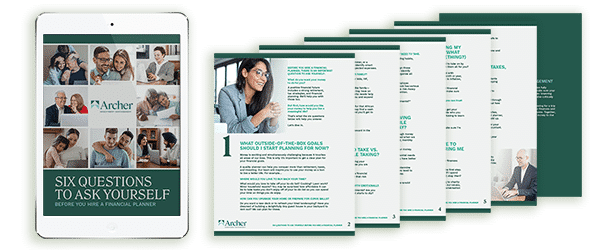
Have you ever imagined what it would feel or look like to be stress-free about money? It’s not uncommon for most people, wealthy or not, to worry about money. One study found that money was the leading cause of stress among Americans, and 64% of people consider money to be a somewhat or very significant source of stress. (1)
While there’s no guarantee that any amount of planning or investing can cure all of your worries, taking proactive control of your financial situation and future can significantly help you feel more confident. At Archer Investment Management, we like to tackle financial planning in five different areas, each of which is designed to improve your life in a unique way. Together, these strategies cohesively work together to help you pursue your goals and visualize what financial peace can look like for you and your family.
1. LIFE PLANNING
Before you can accomplish something, you need a goal. Otherwise, you’re essentially driving blind without a map for guidance. The foundation of a strong financial plan is clarity regarding what you want to accomplish now and in the future. In this area of financial planning, it’s important to consider:
- When do I want to retire?
- What do I want to achieve in 5, 10, and 20 years?
- Do I plan on expanding my family or sending a child to college?
- What does a comfortable lifestyle look like?
Addressing these questions can help you prioritize your objectives and define what steps to take.
2. INVESTMENT PLANNING
Investing can play a powerful role in your financial planning, but it’s overwhelming for most people. Investing doesn’t have to be scary if you have set intentions, needs, and a partner to guide your decisions.
Along with identifying your overall money goals, you’ll want to consider your investments and how they are working for or against you. This involves asking:
- Is my money working as hard for me as it can be?
- Am I paying fees that are too high?
- Do I have too much risk in my portfolio?
- Do I understand what I’m investing in?
The more you understand about your portfolio, investment opportunities, and goals, the more you can feel confident about how your money is working for you.
3. ESTATE PLANNING
Beyond your personal goals, you likely have dreams for your children, grandchildren, loved ones, or charitable organizations. Estate planning helps you have a stronger handle on where your money will go and how it will be used in the future. When considering your estate, you’ll want to ask:
- Does my family know my intentions should I ever become incapacitated?
- Have I named and updated my beneficiaries?
- Is my estate subject to federal estate taxes?
- Does my family know where our important household documents are stored?
Planning for your estate can help both you and your family feel more confident about the future and any decisions they may have to make in an emergency.
4. INSURANCE PLANNING
There’s no such thing as a life without risk, but you can actively work to reduce its negative impact. Too often, people push insurance off to the back burner without realizing how important of a role it can play in their life. As you consider these other elements of your finances, ask yourself the following:
- Am I and my loved ones protected from an unexpected life event?
- Would an illness permanently derail my retirement?
- How would we budget if I or my spouse could no longer work?
As they say, expect the best and plan for the worst. Insurance may seem like betting against yourself, but just as you wouldn’t drive without auto insurance or go without health insurance, put a plan in place to safeguard your wealth.
5. TAX PLANNING
Last but not least, there are taxes, which play a role in everyone’s financial life. Many people don’t realize that there are legal ways to reduce the amount of taxes you have to pay, which means more money in your pocket and for your future retirement. Beyond your annual tax return and taking advantage of credits, consider the following questions:
- Do I have an executive compensation plan?
- Am I taking maximum advantage of my tax-deferred savings opportunities?
- Are there other opportunities for me to save for retirement while reducing taxes?
Tax planning and retirement planning can work hand-in-hand, especially if you collaborate with both your CPA and financial advisor.
PURSUING YOUR IDEAL FINANCIAL FUTURE
Addressing all of these questions and creating a detailed plan to pursue your goals can help guide you toward greater financial confidence and peace. At Archer Investment Management, we help our clients build comprehensive financial plans and provide them a customized website that helps them monitor their progress. We believe this helps our clients stay engaged with their plan and understand how they can take small steps to work toward big goals.
If you’re interested in learning more about what your financial future can look like and how to start taking steps toward your goals, I encourage you to reach out to me. You can book an appointment online here so we can talk about your answers to these questions and what you’d like to accomplish.
About Richard
Richard Archer is a financial advisor and the President of Archer Investment Management with more than eighteen years of industry experience. Largely working with successful individuals and couples, he specializes in providing comprehensive investment guidance and personalized care and attention to each client. Along with holding a Bachelor of Science in Economics and a MBA, he is a CERTIFIED FINANCIAL PLANNER™ certificant and a Chartered Financial Analyst®. He combines his advanced industry education and knowledge with his genuine care for people to provide clients with an exceptional experience. To learn more about Richard, connect with him on LinkedIn or visit www.archerim.com.
__________
(1) http://www.apa.org/news/press/releases/stress/index.aspx















